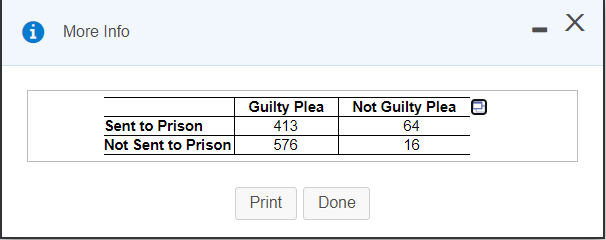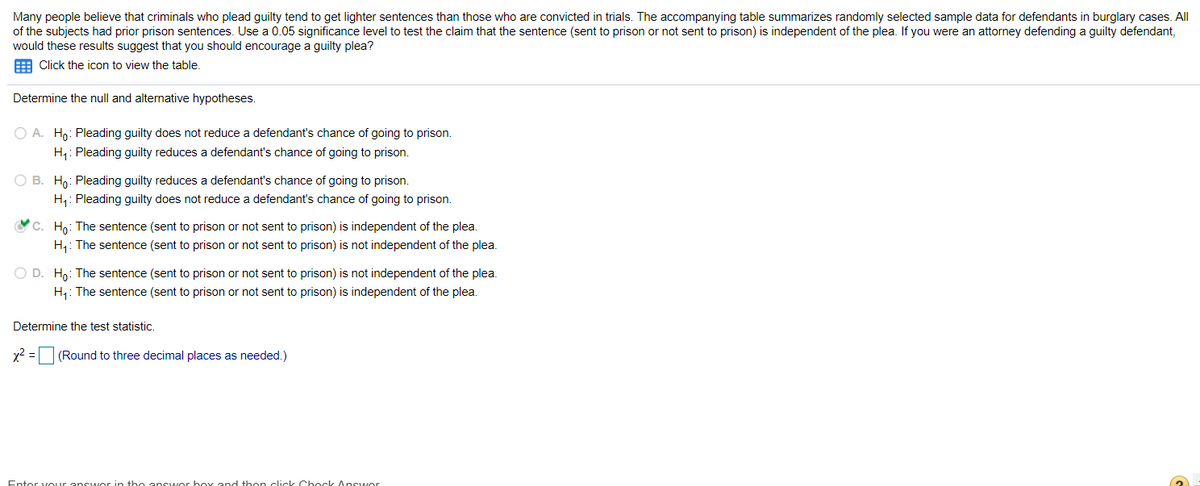Many people believe that criminals who plead guilty tend to get lighter sentences than those who are convicted in trials. The accompanying table summarizes randomly selected sample data for defendants in burglary cases. All of the subjects had prior prison sentences. Use a 0.05 significance level to test the claim that the sentence (sent to prison or not sent to prison) is independent of the plea. If you were an attorney defending a guilty defendant, would these results suggest that you should encourage a guilty plea? E Click the icon to view the table. Determine the null and alternative hypotheses. O A. Ho: Pleading guilty does not reduce a defendant's chance of going to prison. H,: Pleading guilty reduces a defendant's chance of going to prison. O B. Ho: Pleading guilty reduces a defendant's chance of going to prison. H,: Pleading guilty does not reduce a defendant's chance of going to prison. VC. Ho: The sentence (sent prison or not sent to prison) is independent of the plea, prison or not sent to prison) is not independent of the plea. H: The sentence (sent O D. Hn: The sentence (sent to prison or not sent to prison) is not independent of the plea. H,: The sentence (sent prison or not sent to prison) is independent of the plea. Determine the test statistic. x2 = (Round to three decimal places as needed.) Entor vour answor in the answor boy and thon click Chock Answor
Many people believe that criminals who plead guilty tend to get lighter sentences than those who are convicted in trials. The accompanying table summarizes randomly selected sample data for defendants in burglary cases. All of the subjects had prior prison sentences. Use a 0.05 significance level to test the claim that the sentence (sent to prison or not sent to prison) is independent of the plea. If you were an attorney defending a guilty defendant, would these results suggest that you should encourage a guilty plea? E Click the icon to view the table. Determine the null and alternative hypotheses. O A. Ho: Pleading guilty does not reduce a defendant's chance of going to prison. H,: Pleading guilty reduces a defendant's chance of going to prison. O B. Ho: Pleading guilty reduces a defendant's chance of going to prison. H,: Pleading guilty does not reduce a defendant's chance of going to prison. VC. Ho: The sentence (sent prison or not sent to prison) is independent of the plea, prison or not sent to prison) is not independent of the plea. H: The sentence (sent O D. Hn: The sentence (sent to prison or not sent to prison) is not independent of the plea. H,: The sentence (sent prison or not sent to prison) is independent of the plea. Determine the test statistic. x2 = (Round to three decimal places as needed.) Entor vour answor in the answor boy and thon click Chock Answor
Glencoe Algebra 1, Student Edition, 9780079039897, 0079039898, 2018
18th Edition
ISBN:9780079039897
Author:Carter
Publisher:Carter
Chapter10: Statistics
Section10.6: Summarizing Categorical Data
Problem 30PPS
Related questions
Question

Transcribed Image Text:More Info
Guilty Plea
Not Guilty Plea
Sent to Prison
413
64
Not Sent to Prison
576
16
Print
Done

Transcribed Image Text:Many people believe that criminals who plead guilty tend to get lighter sentences than those who are convicted in trials. The accompanying table summarizes randomly selected sample data for defendants in burglary cases. All
of the subjects had prior prison sentences. Use a 0.05 significance level to test the claim that the sentence (sent to prison or not sent to prison) is independent of the plea. If you were an attorney defending a guilty defendant,
would these results suggest that you should encourage a guilty plea?
E Click the icon to view the table.
Determine the null and alternative hypotheses.
O A. Ho: Pleading guilty does not reduce a defendant's chance of going to prison.
H,: Pleading guilty reduces a defendant's chance of going to prison.
O B. Ho: Pleading guilty reduces a defendant's chance of going to prison.
H,: Pleading guilty does not reduce a defendant's chance of going to prison.
C. Ho: The sentence (sent to prison or not sent to prison) is independent of the plea.
H4: The sentence (sent to prison or not sent to prison) is not independent of the plea.
O D. Ho: The sentence (sent to prison or not sent to prison) is not independent of the plea.
H: The sentence (sent to prison or not sent to prison) is independent of the plea.
Determine the test statistic.
x2 =
(Round to three decimal places as needed.)
Entor vour ans wor in tbo answor box and thon click Chock Ans wor
Expert Solution
This question has been solved!
Explore an expertly crafted, step-by-step solution for a thorough understanding of key concepts.
This is a popular solution!
Trending now
This is a popular solution!
Step by step
Solved in 2 steps with 2 images

Knowledge Booster
Learn more about
Need a deep-dive on the concept behind this application? Look no further. Learn more about this topic, statistics and related others by exploring similar questions and additional content below.Recommended textbooks for you

Glencoe Algebra 1, Student Edition, 9780079039897…
Algebra
ISBN:
9780079039897
Author:
Carter
Publisher:
McGraw Hill

College Algebra (MindTap Course List)
Algebra
ISBN:
9781305652231
Author:
R. David Gustafson, Jeff Hughes
Publisher:
Cengage Learning

Glencoe Algebra 1, Student Edition, 9780079039897…
Algebra
ISBN:
9780079039897
Author:
Carter
Publisher:
McGraw Hill

College Algebra (MindTap Course List)
Algebra
ISBN:
9781305652231
Author:
R. David Gustafson, Jeff Hughes
Publisher:
Cengage Learning